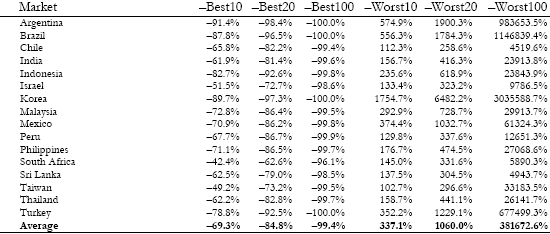Can investors/traders outperform by exploiting (or avoiding) the black swans that populate daily emerging market equity returns? In his September 2008 paper entitled “Black Swans in Emerging Markets”, Javier Estrada investigates the influence of the best and worst days on long-term equity returns in emerging markets and the naive likelihood that investors can predict when these outliers will occur. Using evidence from 16 international equity markets and over 110,000 daily returns from start dates based on data availability through 2007, he concludes that:
- Black swan days exist in emerging equity markets, and their impact on long-term performance is even larger than in developed markets.
- Extreme daily returns in emerging equity markets occur at a frequency far higher than expected from a normal distribution.
- On average across all 16 markets, missing the best 10, 20 and 100 days reduces terminal wealth (relative to a passive investment) by 69%, 85%, and 99%. Avoiding the worst 10, 20 and 100 days increases terminal wealth by 337%, 1,060%, and 381,672%. (See the table below for country by country data.)
- Given that 10 days represent on average just 0.15% of the trading days for a market, the odds of successfully timing extreme returns are very low.
- This evidence suggests that investors should diversify broadly to mitigate exposure to negative black swans while preserving some exposure to positive black swans.
The following table, extracted from the paper, shows the dramatic impact of black-swan days on the terminal values of one unit of local currency invested on country subsample start dates (ranging from 1/4/62 to 12/31/87)) and held passively through 12/31/07 for 16 emerging markets. The columns “-Best10,” “-Best20” and “-Best100” list effects on terminal values for missing just the best 10, 20 and 100 days. The columns “-Worst10,” “-Worst20” and “-Worst100” list effects on terminal values for avoiding just the worst 10, 20 and 100 days.

In summary, very small numbers of extreme return days have a massive impact on long-term stock returns in emerging markets. The naive probability of predicting which days will be extreme is very low.